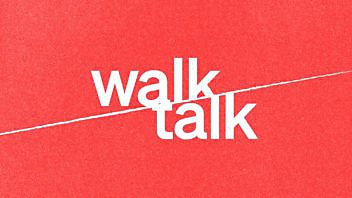Tone of voice is still, flabbergastingly, the most under-exploited power behind great B2B brands.
Pretty much every category of every market has a company that rose to the top not by saying new things but by saying things in a fresh, distinctive way.
From MailChimp to Marketing Profs, Slack to Xero, Drift to Box to Hubspot, Typeform, Wistia… (the list goes on and… actually it doesn’t go on for that long at all).
They all speak to the world with a warm, clear, simple voice. Some are charming and funny. Others just straight and bullshit-free. But they all use voice to send a confident, authentic mojo into the world that acts on humans like magnets act on iron filings and… fridges and stuff.
That’s why it’s still utterly shocking to me that so few B2B brands invest time and energy on their voice. (Wake up and smell the coffee, CMOs).
But behind—and arguably deeper than—voice is something just as important and never discussed: stance.
To understand the power of stance, you need to trace back the power of voice to its roots.
Trust x Distinctiveness = Gimme some of that
A great brand voice works because it signals trustworthiness. It does that by suggesting authenticity: the sense that a person or brand or company really is what it claims to be; really means what it says; really has nothing to hide.
A strong brand voice also works because it signals a ‘who’ instead of a ‘what’. A person instead of an organization. It sounds and feels different from the standard marketing-speak or business jargon or tech-talk that have marked the ‘business-to-buyer’ interaction for the past century or so.
In a standard business marketing context, an authentic voice can deliver a series of tiny surprises that add up to a sense that ‘these people might be for real when they say they have my interests at heart’.
A distinctive personality, underpinned by authenticity, leads to likeability and trust. Voice can do all that. But not all on its own.
Because voice is at its most authentic when it’s consistent with action. And that’s where stance comes in.
(We could just call it ‘behavior’ but ‘stance’ suggests a tight pairing with voice; a twin sibling. And that’s how we want marketers to think about it).
Voice is how you talk, stance is what you do.
While strong brands say things differently, the very best brands also do different things.
Things that demonstrate the company’s beliefs and values instead of just claiming them.
Things that put the needs of a community (a horizontal market, a vertical industry, a discipline, a society…) before the short-term goals of the company.
Things that prove what voice can only suggest.
Words are good.
Words matter.
But actions eat words for breakfast. (And both together? Unstoppable.)
The perils of ‘voicewashing’
As consumers of marketing, we’re all a lot more skeptical than we used to be. Brands that paint themselves green or dip their toes into hot social issues are increasingly being called out for hypocrisy then publicly flogged by the Intermob.
So if you use a kooky, playful voice as a cover for a sneaky, venal business, it will backfire. That’s voicewashing. (Ooh, I like that).
And if you make soothing, calming sounds about your ‘concern’ for childhood obesity while selling a billion cans of sugar-water a day, people will see you for what you are (“Taste the feeling!” my red, dynamic-ribboned arse.)
When brands use voice as a veneer, they collectively act to undermine the power of voice itself. To make people suspicious of the very attractiveness of an apparently authentic voice.
But when brands use voice to express authentic values, then stance comes in to show that it’s okay to trust that feeling. That this isn’t just voicewashing.
The walk plus the talk
Just as stance works to reinforce trust, it also works to support those signals of distinctiveness every brand wants.
If you do the exact same things that everyone else does, then voice may be your only chance to differentiate (a chance that you squander at your peril).
But if you do remarkable things, it matters less how you talk about them. Voice will still play an important role in everything you say, but stance will put a body to that voice.
Stance in action
Sometimes stance is about investing in something that may never move any of your KPI dials and revenue meters:
- Basecamp produced The Distance, an impressive, three-year project about businesses that have thrived for over 25 years. It isn’t a lead-gen play. It’s a celebration of longevity in an era of the quick-flip and growth hack. (Ann Handley, the Viscountess of Voice, writes about it in this post, Basecamp Is Barking Up The Long Tree (nice headline, Ann). Yes, the stories in The Distance are told in a warm, clear, journalistic voice. But it’s the act of bringing these stories to the world that makes the impact. It’s the stance.
- Stripe invests in startup success. They don’t just claim to help start-ups succeed on the internet, they created Stripe Atlas, a complete start-up toolkit that’s free for everyone. Harry wrote about it in the post, What Marketers Should Learn From Stripe Atlas.
Or your stance might be about giving back:
- Salesforce gives 1% of its equity, product and employee’s time to charity. That big, bold, generous stance speaks far louder than a mountain of cute micro-copy. Through it, they’ve given over a hundred million dollars to charities, while recruiting other companies to Pledge 1%. The 1% pledge isn’t a peripheral CSR play. It’s central to the Salesforce brand. You can’t go to a Dreamforce or World Tour event without hearing some incredible stories about the people touched by this program. It’s real. [Disclosure: a Velocity client]
Stance is also about doing things that contribute to your market not just your brand:
- ChiefMartec (Scott Brinker’s alter ego) publishes the Marketing Technology Supergraphic to help an emerging market market hold a conversation about itself. We write about ‘Brinker’s Beast’ in this post: Let’s Steal From The Marketing Technology Supergraphic). Scott has a smart, clear, compelling voice. But it’s the generosity and geekiness of the Supergraphic that drives home what he’s all about. It’s the irresistible formula of voice x stance.
- Adobe publishes CMO.com. Instead of just saying they’re there to help marketers, they… help marketers. (See our interview with founding editor, Tim Moran). There’s some powerful ROI in CMO.com. But it’s a long-game ROI—and it shines out in contrast to the marketing playbook defined by ‘me-me-me-now-now-now’. [Disclosure: not a Velocity client yet but we really want them to be].
Stance is often like that, thinking long-term instead of always acting for revenue today:
- Sprint set out to produce the Internet’s best explanation of 5G. Not to sell stuff today (5G isn’t live yet) but to help businesses understand why it’s such a big deal. [Disclosure: a Velocity program, and damn proud of it]. Yes, it’s marketing. All this is marketing. But it’s doing stuff instead of only saying stuff.
It’s also simply about practicing what you preach, in public:
- GE doesn’t just say, “We’re innovative!”, their marketing has been a firehose of experimentation for years, from the 6-Second Science Fair on Vine (remember Vine?) to the sci-fi podcast The Message, to the Breakthrough documentary series on Nat Geo, to cool, geeky, beautiful videos like Paths of Flight to… the list is way too long. These guys walk the innovation talk.
BTW, experimentation in public is a great stance for tech companies:
- Typeform doesn’t just urge marketers to be more experimental, they run experiments and report on them, like Locked In, an interactive video, shot, edited and coded in 36 hours as part of The Typeform Challenge, a company hackathon event. There’s zero sense that this was simply a stunt to project the appearance of a learning culture. This is an authentic learning culture, doing its learning in public… and having a ball in the process.
So are you going to take a stance?
Tone of Voice is worth every bit of the time, energy and resources you can put into it. But as you think about voice, pull the camera back and take a wider view.
Look at the things your marketing team and your company are actually doing not just at how you’re speaking.
If you can put the two together… I pity your competitors.
(Not really: screw the uptight, corporate clones. They get what they deserve).
Got any examples of companies using stance to walk the talk? Drop me a comment or an email (doug@). I’d love to hear about it.
Enjoyed this article?
Take part in the discussion









Comments
Kendra Futcher Writing & Thinking March 5th, 2019
Yes, completely agree. And LOVE ‘voicewashing’! Merck are a great example of a brand/business backing up TOV with stance. Curiosity is a big part of their brand and they really live/work it.
Doug Kessler March 11th, 2019
Thanks, Kendra! I’m seeing more and more voicewashing out there.
The traditionally beleaguered brands (tobacco, fast food, soft drinks, oil) are well trained in it but it’s happening in B2B too.
Will look out for the Merck work.